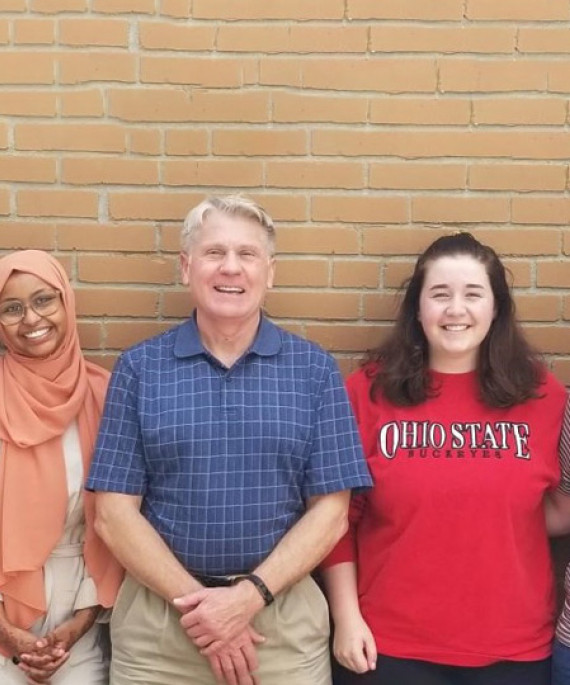
Even those with two-year degrees are 4.5 times less likely to die by opioid overdose than those earning a high school diploma alone.
Four-year grads have dramatically lower rates of opioid overdose
Experts have known for years that people with high school degrees lag behind those with college diplomas in key economic areas.
But in a newly released policy brief, Ohio State researchers say that another potential outcome of that disparity could be fatal. Ohioans who have only high school degrees have opioid overdose rates 14 times higher than those with four-year college degrees.
The finding resoundingly points to the need for better and more education in the state, where opioid deaths are nearly double the national average, the brief concludes.
“You look at other trends and they usually diverge by a factor of 2 or 3, but to be 14 times more likely to overdose, it’s pretty shocking,” said Michael Betz, assistant professor of human development and family science at the College of Education and Human Ecology.
Betz coauthored the brief with postdoctoral researcher Mark Rembert, doctoral student Bo Feng and Professor Mark Partridge, all in the College of Food, Agriculture and Environmental Sciences Department of Agricultural, Environmental and Development Economics. The team assesses a variety of data gathered from state and federal sources to produce the brief.
Even those with two-year degrees fared far better, being 4.5 times less likely to die by overdose. High school dropouts were not included in the data source, but would likely drive the numbers still higher, Betz said.
A perfect storm
In the ’60s and ’70s, manufacturing jobs in rural Ohio towns — where the crisis is pronounced — supported high-school graduates. Since permanent trade relations were established with China, a majority of those jobs have been outsourced or replaced by automation. “There’s been a decline in manufacturing jobs in the long term, but right around 2000 you see it just drop off a cliff,” Betz said. This trend has forced low-skilled workers into retail or service jobs without health insurance or opportunities to advance.
“There’s a lot less opportunity for someone with a high school degree to make that middle-class wage where they can buy a house, support a family and have a place in society,” Betz said.
Many of Ohio’s rural towns, he said, have lost their dynamism. Suicide rates, particularly among white, working-age males, have increased. So has drug use. And yet, mental health and drug treatment services are often an hours-long drive away.
“You can see how this can become a perfect storm,” Betz said.
Opioid overdose is the leading cause of death for Ohioans under the age of 55, the brief states, outpacing cancer, heart disease and suicide. And these deaths are just a subset: As many 170,000 Ohioans, or nearly 1.5 percent of the population, were abusing or dependent on opioids in 2015, the authors say.
“If you want to assess how big the problem is, users and addicts probably heavily overlap with regard to opioids,” Betz said. “That’s a very difficult thing to get a handle on.”
According to a recent national study cited by the policy-brief authors, half of prime-age men out of work are taking daily pain medication. Whether they’ve sustained injuries working in physical, low-skilled jobs or are taking drugs because they are disenfranchised will require further study, Betz said.
But experts agree: This opioid crisis isn’t going away anytime soon.
In his office, Betz pointed to graph charting drug overdose deaths since the late 1990s. Most line charts show a steady curve over time. This one rises in a near-vertical ascent from 2015 on.
“We haven’t even started to change our rate, or bend (the line) to flatten,” he said. “We’re still accelerating.”
As automation and artificial intelligence begin to do even more complex jobs, such as driving semitrucks and analyzing insurance claims, more people will be at risk of losing jobs. Unless the trend reverses, opioid abuse could spike even further.
That’s where education comes in, Betz said.
“In the medium term, what we can do for those entering elementary school and just being born now is give them a higher quality education,” he said. “Forty or 50 years down the road, there will still be complex tasks that well-trained people will be able to do.”
Setting people on the trajectory to do complex, high-skilled jobs starts before a child is born, he said, when brain development is happening, and particularly during the first few years of life.
The policy brief stresses the critical importance of early childhood education and intervention, particularly for children of poor families. It also cites growing evidence that higher education improves overall health of individuals.
Finally, it exhorts policymakers to reduce barriers to higher education. Doing so, the authors say, “will decrease the percentage of adults who believe they have little to offer the labor market.”
And that, they hope, will give more of them an opportunity to pursue healthy, drug-free lives.




